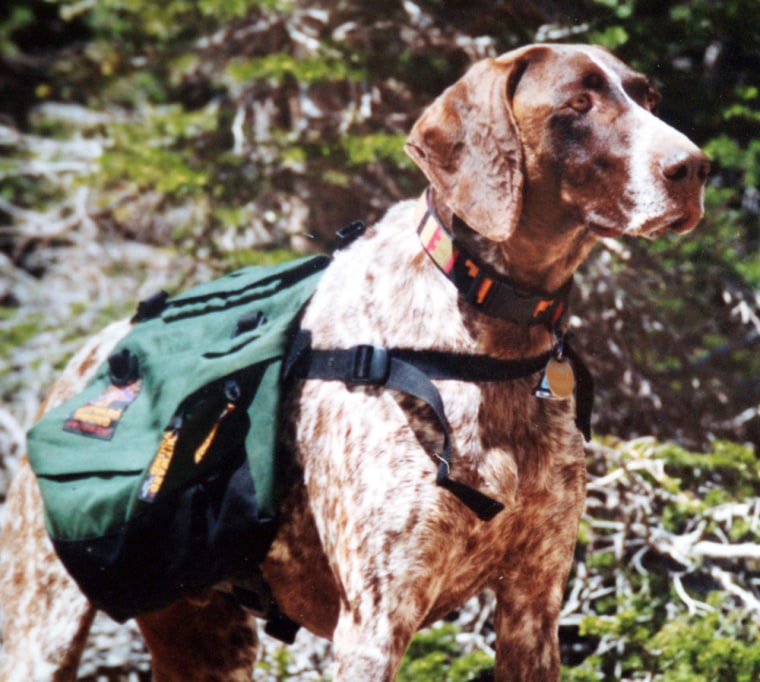People who love to hike find taking along a four-legged companion can have physical benefits for both ends of the leash.
Studies show people are more successful at losing weight when they do it with a friend. What better friend than a dog to provide company and keep a person on track, said Randy Galbraith, who began taking his German shorthaired pointer hiking five years ago.
“To me, it’s a treasure to be with Fritz. Everyday he has to have his run, no matter what,” Galbraith said. “He’ll give you a look that says, ’It’s time to go.”’
Neither Galbraith nor Fritz struggles with weight problems. Galbraith does, however, find the need to release the stress that comes from being principal of an alternative high school for troubled youths in Springfield.
“You can clear your head of everything that’s going on and reclaim yourself when you’re out in the wilderness,” he said. “Being with Fritz gives me a lot of quiet time to relax and think.”
Galbraith starts planning his summer vacation to hike in the backcountry out West when the winter doldrums set in and there’s still snow in southwest Missouri. He is particularly fond of Colorado, Montana and New Mexico.
The two generally hike between six miles and 12 miles daily. Fritz, who carries his own water and snacks in a backpack, is obedient and roams free while they are alone. Galbraith gives commands in German, a tribute to his grandmother.
“We have a good communication system,” he said. “If he’s off his leash, he’s constantly running ahead and then coming back to check on me.”
Doug Gelbert, author of The Canine Hiker’s Bible, said dogs love to sniff and explore and can offer new insight into the outdoors.
“As a dog walks along, sometimes he perks up his ears and looks at stuff that we don’t even recognize,” he said.
Fritz led Galbraith to the moose antlers that are displayed in his school office. The dog also has allowed him to see wildlife that he might not have noticed on his own.
“He was once chased by a cow moose that was protecting its young,” Galbraith said. “I never would have noticed it, if it hadn’t been for Fritz.”
Start slow
Richard Meadows, a veterinarian and director of community practice at University of Missouri’s College of Veterinary Medicine, advises both human and canine who haven’t been exercising regularly to start slow.
Like their owners, American dogs are putting on pounds, too. They may not watch TV or play video games but they may spend lots of time napping.
“The numbers seem to range somewhere between 15 and 25 percent of the dogs and cats in the United States are obese,” Meadows said.
The risks of being overweight are the same, whether you have two legs or four, he said. They include heart and joint disease, diabetes, cancer and a shortened life span.
“Just like us, they can’t be dumped into a program. They need to work into it and build muscle tone and endurance,” said Meadows, who has been a researcher in several animal exercise studies.
He said dogs should be examined after hikes for footpad injuries, strained muscles, as well as ticks and fleas.
People also should remember that their dog is wearing a fur coat on and has a lower tolerance for heat, Meadows said, and they need lots of water.
Opinions differ on what type of dog is best for trails. Gelbert, who has been hiking with dogs for about 20 years, suggests people tailor their selection to how they want to hike. Information about the various breeds can be easily found on the Internet and through kennel clubs.
And to avoid disappointment, hikers should call ahead to make sure the site they plan to visit allows dogs on trails.
Gelbert created the web site, hikewithyourdog.com, to help people find dog-friendly parks and trails.
As a general rule, he said dogs are only allowed to go where cars can go in national parks. They are allowed on most national forest trails, although access can sometimes be remote. There are few bans, however, on dogs in national historical parks. Dog owners also need to be responsible, Gelbert said.
“It always bothers me when I see a sign that says, ’No dogs allowed,”’ he said. “It seems to me that it would be much better to put up a sign that says, ’Dog owners, every time you come out with your dog, you are an ambassador for every other dog using these parks.”’
